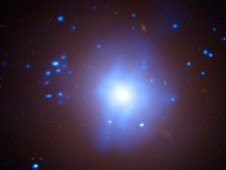New results from NASA's Chandra X-ray Observatory and the Magellan telescopes suggest that a dense stellar remnant has been ripped apart by a black hole a thousand times as massive as the Sun. If confirmed, this discovery would be a cosmic double play: it would be strong evidence for an intermediate mass black hole, which has been a hotly debated topic, and would mark the first time such a black hole has been caught tearing a star apart.

This scenario is based on Chandra observations, which revealed an unusually luminous source of X-rays in a dense cluster of old stars, and optical observations that showed a peculiar mix of elements associated with the X-ray emission. Taken together, a case can be made that the X-ray emission is produced by debris from a disrupted white dwarf star that is heated as it falls towards a massive black hole. The optical emission comes from debris further out that is illuminated by these X-rays.
The intensity of the X-ray emission places the source in the "ultraluminous X-ray source" or ULX category, meaning that it is more luminous than any known stellar X-ray source, but less luminous than the bright X-ray sources (active galactic nuclei) associated with supermassive black holes in the nuclei of galaxies. The nature of ULXs is a mystery, but one suggestion is that some ULXs are black holes with masses between about a hundred and several thousand times that of the Sun, a range intermediate between stellar-mass black holes and supermassive black holes located in the nuclei of galaxies.

This scenario is based on Chandra observations, which revealed an unusually luminous source of X-rays in a dense cluster of old stars, and optical observations that showed a peculiar mix of elements associated with the X-ray emission. Taken together, a case can be made that the X-ray emission is produced by debris from a disrupted white dwarf star that is heated as it falls towards a massive black hole. The optical emission comes from debris further out that is illuminated by these X-rays.
The intensity of the X-ray emission places the source in the "ultraluminous X-ray source" or ULX category, meaning that it is more luminous than any known stellar X-ray source, but less luminous than the bright X-ray sources (active galactic nuclei) associated with supermassive black holes in the nuclei of galaxies. The nature of ULXs is a mystery, but one suggestion is that some ULXs are black holes with masses between about a hundred and several thousand times that of the Sun, a range intermediate between stellar-mass black holes and supermassive black holes located in the nuclei of galaxies.
No comments:
Post a Comment